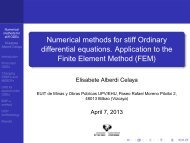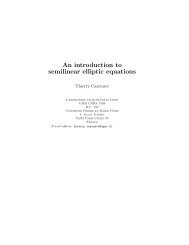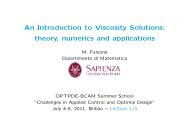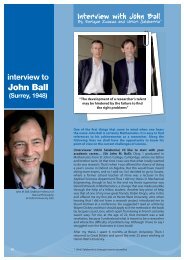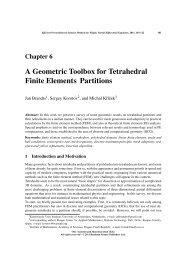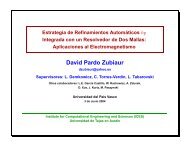High-order mixed weighted compact and non-compact scheme for ...
High-order mixed weighted compact and non-compact scheme for ...
High-order mixed weighted compact and non-compact scheme for ...
Create successful ePaper yourself
Turn your PDF publications into a flip-book with our unique Google optimized e-Paper software.
<strong>High</strong>-<strong>order</strong> <strong>mixed</strong> <strong>weighted</strong> <strong>compact</strong><strong>and</strong> <strong>non</strong>-<strong>compact</strong> <strong>scheme</strong> <strong>for</strong>shock/discontinuity <strong>and</strong> small lengthscale interactionGoran StipcichChaoqun LiuTechnical Report 2011-10http://www.uta.edu/math/preprint/
<strong>High</strong>-<strong>order</strong> <strong>mixed</strong> <strong>weighted</strong> <strong>compact</strong> <strong>and</strong> <strong>non</strong>-<strong>compact</strong> <strong>scheme</strong> <strong>for</strong>shock/discontinuity <strong>and</strong> small length scale interactionGoran Stipcich 1 <strong>and</strong> Chaoqun Liu 2UNIVERSITY OF TEXAS AT ARLINGTON, ARLINGTON, TX 76019, USACLIU@UTA.EDUAbstractIt is critical <strong>for</strong> numerical <strong>scheme</strong> to obtain numerical results as accurate as possible with limitedcomputational resources. Turbulent processes are very sensitive to numerical dissipation, which maydissipate the small length scales. On the other h<strong>and</strong>, dealing with shock waves, capturing <strong>and</strong>reproducing of the discontinuity may lead to <strong>non</strong>-physical oscillations <strong>for</strong> <strong>non</strong>-dissipative <strong>scheme</strong>s. Inthe present work, a new high-<strong>order</strong> <strong>mixed</strong> <strong>weighted</strong> <strong>compact</strong> <strong>and</strong> <strong>non</strong>-<strong>compact</strong> (WCNC) difference<strong>scheme</strong> is proposed <strong>for</strong> accurate approximation of the derivatives in the governing Euler equationsalthough the idea was given by Xie <strong>and</strong> Liu in 2007. The basic idea is to recover the <strong>non</strong>-dissipative high<strong>order</strong><strong>weighted</strong> <strong>compact</strong> <strong>scheme</strong> (WCS) where solution is smooth, while using a lower-<strong>order</strong>ed <strong>non</strong><strong>compact</strong><strong>scheme</strong> <strong>for</strong> near-shock areas. Formulation <strong>and</strong> numerical tests are per<strong>for</strong>med <strong>for</strong> the onedimensional case <strong>and</strong> results are compared with the well established <strong>weighted</strong> essentially <strong>non</strong>oscillatory(WENO) <strong>scheme</strong> <strong>and</strong> WCS.1. IntroductionIt is desirable <strong>for</strong> a numerical <strong>scheme</strong> to attain high-<strong>order</strong> accuracy having limited computationalresources. In the past two decades, many ef<strong>for</strong>ts have been made in development such high-<strong>order</strong><strong>scheme</strong>s, such as <strong>compact</strong> difference <strong>scheme</strong>s (Lele, 1992; Visbal, et al., 2002; Yee, 1997), essentially<strong>non</strong>-oscillatory (ENO) <strong>scheme</strong>s (Shu, et al., 1988; Shu, et al., 1989; Harten, et al., 1997) <strong>and</strong> their<strong>weighted</strong> variant (WENO) (Liu, et al., 1994; Jiang, et al., 1996; Shu, 2009), discontinuous Gelerkin (DG)methods (Cockburn, et al., 1989; Cockburn, et al., 1998; Cockburn, 2003; Bassi, et al., 1997), spectralelement (SE) methods (Patera, 1984), spectral volume methods (SVM) (Wang, 2002; Liu, et al., 2006),spectral difference methods (SDM) (Liu, et al., 2006; Sun, et al., 2007), low dissipative high-<strong>order</strong><strong>scheme</strong>s (Yee, et al., 2000), group velocity control <strong>scheme</strong>s (Ma, et al., 2001), <strong>and</strong> hybrid <strong>scheme</strong>s(Adams, et al., 1996 ; Wang, et al., 2002).Physical processes usually have various different length scales. In the case of flow transition <strong>and</strong>turbulence, <strong>for</strong> example, small length scales are of great interest <strong>and</strong> very sensitive to any artificialnumerical dissipation. A high <strong>order</strong> central <strong>compact</strong> <strong>scheme</strong> (Lele, 1992; Visbal, et al., 2002) is <strong>non</strong>dissipativewith high-<strong>order</strong> <strong>and</strong> high-resolution, <strong>and</strong> thus appropriate <strong>for</strong> the solution of flow transition<strong>and</strong> turbulence cases. However, in many engineering applications such as shock-boundary layer1 Visiting PhD student2 Professor & AIAA Associate Fellow
interaction, shock-acoustic interaction, image process, flow in porous media, multiphase flow <strong>and</strong>detonation wave, there is a presence of both different length scales <strong>and</strong> shocks/discontinuities.The shock can be considered as a discontinuity or a mathematical singularity (there is no classicalunique solution <strong>and</strong> the derivatives are not bounded). In the near-shock region, continuity <strong>and</strong>differentiability of the governing Euler equations are lost <strong>and</strong> only the weak solution can be obtained. Influid dynamics it is possible to have a shock solution when considering, <strong>for</strong> instance, the super-sonicregime of the Euler equations, which are hyperbolic. Hyperbolic systems can be solved taking advantageof the characteristic lines <strong>and</strong> Riemann invariants. The physics of the shock indicate that the derivativeacross the shock is not finite, <strong>and</strong> that the downstream region cannot influence the upstream one. In theframework of finite differences, it makes no sense to use, <strong>for</strong> instance, a high <strong>order</strong> <strong>compact</strong> <strong>scheme</strong>,which takes all grid point on both sides of a shock into account <strong>for</strong> the numerical approximation of thederivatives. Apparently, the upwind strategies are more suitable than <strong>compact</strong> <strong>scheme</strong>s in dealing withshocks, <strong>and</strong> indeed history has shown a great success of upwind technologies applied to hyperbolicsystems. Among upwind or bias upwind <strong>scheme</strong>s that are capable to capture a shock sharply, there areGodunov (Godunov, 1959), Roe (Roe, 1981), MUSCL (van Leer, 1997), TVD (Harten, 1983), ENO (Harten,et al., 1997; Shu, et al., 1988; Shu, et al., 1989) <strong>and</strong> WENO (Liu, et al., 1994; Jiang, et al., 1996). Allmentioned <strong>scheme</strong>s above are based on upwind or bias upwind technology <strong>and</strong> are well suited <strong>for</strong>hyperbolic systems. On the other h<strong>and</strong>, upwinding strategies are not desirable <strong>for</strong> solving Navier-Stokessystems, which present a parabolic behavior, <strong>and</strong> are very sensitive to any numerical dissipationespecially when tackling the problem of transitional <strong>and</strong> turbulent flow, where small length scales areimportant.Ef<strong>for</strong>ts have been made in developing high-<strong>order</strong> numerical <strong>scheme</strong>s with high resolution <strong>for</strong> smalllength scales, but at the same time capable of sharply capture the shock/discontinuity withoutgenerating visible numerical oscillations. A combination of WENO <strong>and</strong> st<strong>and</strong>ard central <strong>scheme</strong> isproposed by (Kim, et al., 2005; Costa, et al., 2007), <strong>and</strong> a combination of WENO <strong>and</strong> upwinding <strong>compact</strong><strong>scheme</strong> (UCS) is proposed by (Ren, et al., 2003), but the mixing function is still complex <strong>and</strong> has anumber of case related adjustable coefficients, which is not convenient to use.A <strong>weighted</strong> <strong>compact</strong> <strong>scheme</strong> (WCS) is developed by (Jiang, et al., 2001). WCS is based on using WENO(Liu, et al., 1994) weighting method <strong>for</strong> evaluating c<strong>and</strong>idates which use the st<strong>and</strong>ard <strong>compact</strong> <strong>scheme</strong>.The building block <strong>for</strong> each c<strong>and</strong>idate is a Lagrange polynomial in WENO, but is Hermite in WCS,obtaining <strong>for</strong> the latter a higher <strong>order</strong> of accuracy with the same stencil width. In shock regions, the WCScontrols the contributions of different c<strong>and</strong>idate stencils to minimize the influence of c<strong>and</strong>idatescontaining a shock/discontinuity. On the other h<strong>and</strong>, in regions with smooth solution, WCS recovers thest<strong>and</strong>ard <strong>compact</strong> <strong>scheme</strong> (Lele, 1992) to achieve high accuracy <strong>and</strong> resolution. Numerical tests revealthat the original WCS works well in some cases such as Burgers’ equation, but is not suitable <strong>for</strong> solvingthe Euler equations. As mentioned, the usage of derivatives by <strong>compact</strong> <strong>scheme</strong>s results in globaldependency. WCS minimizes the influence of a shock-containing c<strong>and</strong>idate stencil by assigning a smallerweight, but still uses all of the c<strong>and</strong>idates, resulting in global dependency.In <strong>order</strong> to overcome the drawback of WCS, local dependency has to be achieved in shock areas, whilerecovering global dependency in smooth regions. This fundamental idea leads naturally to thecombination of <strong>compact</strong> <strong>and</strong> <strong>non</strong>-<strong>compact</strong> <strong>scheme</strong>s, that is, to the <strong>mixed</strong> high <strong>order</strong> <strong>weighted</strong> <strong>compact</strong><strong>and</strong> <strong>non</strong>-<strong>compact</strong> <strong>scheme</strong> (WCNC, (Xie, et al., 2007)). However, the mixing coefficient was not definedwell <strong>and</strong> the <strong>scheme</strong> was still very dissipative.The aim of this work is to develop a high <strong>order</strong> <strong>scheme</strong> <strong>for</strong> those cases where both discontinuities (e.g.shocks) <strong>and</strong> small length scales (e.g. sound wave, turbulence) are important. The proposed <strong>scheme</strong>captures the discontinuity (shocks) very sharply by upwinding dominant weights, <strong>and</strong> recovers the high<strong>order</strong> <strong>compact</strong> <strong>scheme</strong> <strong>for</strong> high accuracy <strong>and</strong> high resolution in the smooth area. A black-box type2
subroutine is developed, which can be used <strong>for</strong> any discrete data set to achieve high <strong>order</strong> accuracy f<strong>order</strong>ivatives.The present work is organized as follows. In section 2 the WCNC <strong>for</strong>mulation is described, section 3reports numerical results of test cases <strong>for</strong> the solution of the Euler equation in the one-dimensionalcase, <strong>and</strong> in section 4 conclusions are drawn along with the future work.2. The numerical <strong>scheme</strong>As mentioned, the WCS (Jiang, et al., 2001) uses the ideas of WENO (Liu, et al., 1994) <strong>for</strong> controllingthe contributions of different c<strong>and</strong>idate stencils with the aim of minimizing the influence of thec<strong>and</strong>idate containing a discontinuity. In smooth solution regions, WCS recovers the st<strong>and</strong>ard <strong>compact</strong><strong>scheme</strong> of high <strong>order</strong> <strong>and</strong> high resolution. For a function f, a one-parameter family <strong>compact</strong> <strong>scheme</strong>(Lele, 1992) may be written as + + = 1 h − 112 4 − 1 − 1 3 + 2 + 1 3 + 2 + 112 4 − 1 (2.1)where f i <strong>and</strong> f i ’ denote the function’s known value <strong>and</strong> its unknown derivative, respectively, at the i-thpoint, <strong>and</strong> α is the parameter to be determined <strong>for</strong> highest <strong>order</strong>. If = 1/3, the <strong>scheme</strong> (2.1) recoversthe st<strong>and</strong>ard sixth <strong>order</strong> <strong>compact</strong> <strong>scheme</strong>, corresponding to a symmetric <strong>and</strong> tri-diagonal system. If = 0 only the fourth <strong>order</strong> <strong>non</strong>-<strong>compact</strong> central <strong>scheme</strong> is recovered.WCS has shown to solve well certain test cases, such as the convection equation <strong>and</strong> Burgers’equation, but un<strong>for</strong>tunately numerical solutions of the Euler equations are severely affected bynumerical oscillations due to the use of derivatives by the <strong>compact</strong> <strong>scheme</strong>, which results in globaldependency. WCNC is based on WCS (Jiang, et al., 2001) <strong>and</strong> is aimed to achieve local dependency inareas where discontinuities are present.2.1. Derivation of the WCNC <strong>scheme</strong>For a given point i, three c<strong>and</strong>idate stencils containing the point are defined as S 0 =(x i-2 ,x i-1 ,x i ),S 1 =(x i-1 ,x i ,x i+1 ) <strong>and</strong> S 2 =(x i ,x i+1 ,x i+2 ), as shown in Figure 1.S 0S 2i-2 i-1 i i+ 1 i+ 2S 1Figure 1: C<strong>and</strong>idate stencils <strong>for</strong> an interior point i.3
The one-parameter α-family of the <strong>compact</strong> <strong>scheme</strong> (Lele, 1992) is used. A <strong>compact</strong> <strong>scheme</strong>, namely F 0 ,F 1 <strong>and</strong> F 2 , is derived on each of the stencils S 0 , S 1 <strong>and</strong> S 2 , respectively, as : + = 1 h + + : + + = 1 h + + (2.2) : + = 1 h + + As <strong>for</strong> WCS, each <strong>compact</strong> <strong>scheme</strong> F 0 , F 1 <strong>and</strong> F 2 , will be multiplied with an associated linear weight C 0 ,C 1<strong>and</strong> C 2 , respectively, <strong>and</strong> the summation of the three contributions will lead to the final <strong>scheme</strong> F aswhere the condition on the linear weight has to be satisfied = + + (2.3) + + = 1 (2.4)At this stage, the total number of 16 free parameters has to be determined: , , , , , , , , , , , , , , , .By matching the Taylor series coefficients <strong>for</strong> each lower <strong>order</strong> <strong>compact</strong> <strong>scheme</strong> F 0 , F 1 <strong>and</strong> F 2 , <strong>and</strong>solving <strong>for</strong> the right-h<strong>and</strong> side free parameters in (2.2), the following conditions are obtained = 1 − , = −2, 2 = 3 + ,2 = − 3 − 12 = 2,, = 2 − , = − − 3 − 1, (2.5)2 = − 1 − , 2 = − 3 + .2In <strong>order</strong> to reassemble the st<strong>and</strong>ard sixth <strong>order</strong> <strong>compact</strong> <strong>scheme</strong> (2.1), the following conditions have tobe satisfied4
+ = , + = , + = − 1 3 + 2, + + = 0, + = 1 + 2, (2.6)3 = − 112 4 − 1, = 1 4 − 112where α is treated as a parameter. The above system of equations, together with condition (2.4) <strong>for</strong> thelinear weights, <strong>and</strong> the condition of symmetric <strong>scheme</strong> = , is <strong>non</strong>-linear, <strong>and</strong> is not closed <strong>for</strong>solving the 16 unknowns listed above. An artificial condition may be added in <strong>order</strong> to close the system.In this preliminary study, it is chosen = 3 4(2.7)but future study may lead to a different choice <strong>for</strong> closing the system of equations.Solutions <strong>for</strong> the 16 unknowns of WCNC <strong>scheme</strong> are reported in Table 1.Table 1: Coefficients <strong>for</strong> WCNC <strong>for</strong> condition (2.7) on each of the three stencils , = , , . 5 − 263 − 262 − 15 − 21 32 − 1−2 5 − 2 4 − 133 − 23434 5 − 263 − 262 − 15 − 2 −2 − 3 4 − 1 2 3 32 − 1+2 5 − 20− 3 32 − 1−2 5 − 234 + 1 22 − 1 32 − 1+2 5 − 2All the coefficients in Table 1 vary smoothly <strong>and</strong> monotonically when the parameter α varies from 0 to1/3. Substituting the found coefficients, (2.2) become5
: : : 62 − 15 − 2 + = 1 h 1 232 − 1−5 − 2 − 2 + 3 232 − 1+5 − 2 34 + + 3 4 = 1 h − 3 4 + 1 2 + 3 4 + 1 2 . +62 − 15 − 2 = 1 h − − 3 232 − 1−5 − 2 + 2 − − 1 232 − 1+5 − 2 For the <strong>compact</strong> <strong>scheme</strong>s <strong>and</strong> , corresponding to stencils <strong>and</strong> in (2.8), the calculation ofthe derivative at the i-th grid point, namely , involves the function value at three grid points <strong>and</strong> thevalue of the function’s derivative at one single grid point. Thus the <strong>scheme</strong>s are one-sided, <strong>and</strong> at leastsecond-<strong>order</strong> accurate (third-<strong>order</strong> accurate when = 1/3). For the <strong>compact</strong> <strong>scheme</strong> , correspondingto the stencil in (2.8), the calculation of the punctual derivative involves the function value at twogrid points <strong>and</strong> the function derivative at two grid points. Thus the <strong>scheme</strong> is centered, <strong>and</strong> at leastsecond-<strong>order</strong> accurate (fourth-<strong>order</strong> when = 1/3). As mentioned, the new <strong>scheme</strong> is obtained bymultiplying each equation , <strong>and</strong> in (2.8) with the specific weight assigned, , <strong>and</strong> in Table1, respectively, as specified in (2.3). The proposed <strong>scheme</strong> reproduces the st<strong>and</strong>ard sixth-<strong>order</strong> <strong>compact</strong><strong>scheme</strong> (2.1) when = 1/3, <strong>and</strong> is fourth-<strong>order</strong> accurate <strong>for</strong> 0 ≤ < 1/3.As mentioned above, WCNC uses the WENO (Jiang, et al., 1996) idea <strong>for</strong> calculating the weights <strong>for</strong>the final <strong>scheme</strong>. Instead of using directly , <strong>and</strong> of Table 1, the WENO weights , <strong>and</strong> are used, so (2.3) becomeswhere = = + + (2.9) , = + (2.10)where is a small parameter in <strong>order</strong> to avoid divisions per zero, are the weights defined in Table 1,p is an important parameter <strong>for</strong> controlling the WENO weights, <strong>and</strong> are the smoothnessmeasurements (Jiang, et al., 1996).The final <strong>scheme</strong> obtained using (2.9) is62 − 1 3 + 5 − 2 4 + 3 + 4 + 1h 1 262 − 15 − 2 =32 − 1−5 − 2 − 2 + 3 4 + 1 2 + − 3 32 − 1+2 5 − 2 +2 + 3 4 + 1 2 + − 1 32 − 1+2 5 − 2 . 2.2 Determination of the parameter α6
The only parameter left undetermined so far in the final expression of WCNC <strong>scheme</strong> (2.11) is ,which is crucial <strong>for</strong> the <strong>scheme</strong>s’ per<strong>for</strong>mance. The parameter is determined in relation to thesmoothness of the function. As mentioned, the basic idea is to recover the st<strong>and</strong>ard <strong>compact</strong> <strong>scheme</strong>(2.1) in smooth regions, taking advantage of global dependency of the <strong>compact</strong> <strong>scheme</strong> <strong>for</strong> achievinghigh <strong>order</strong>, <strong>and</strong> to reassemble a lower <strong>order</strong> <strong>scheme</strong>, <strong>non</strong>-<strong>compact</strong>, in regions where discontinuities arepresent. Thus the role of the parameter is to assume the value 1/3 in smooth regions, <strong>and</strong> to rangefrom zero to 1/3 according to the smoothness of the function.In this preliminary study, the <strong>for</strong>mulation adopted is the following = 1 − µ + µ 1 3where µ is a fixed parameter (µ = 0.95 in the present study), <strong>and</strong> = 1 3 − 1 2 − 1 3 + − 1 3 + − 1 3 (2.12)(2.13)The normalized smoothness parameters are = + + (2.14)In smooth regions, the three normalized smoothness parameters are nearly equal, namely ≅ ≅ ≅ 1/3, thus ≅ 1/3 <strong>and</strong> also ≅ 1/3, <strong>and</strong> the sixt-<strong>order</strong> st<strong>and</strong>ard <strong>compact</strong> <strong>scheme</strong> isrecovered achieving global dependency <strong>and</strong> the best resolution. In shock/discontinuity regions, theworst case leads to dramatically different weights <strong>for</strong> the stencils. For instance, if = 1 <strong>and</strong> = = 0, the parameter = 0, so that the local dependency is introduced in the <strong>scheme</strong> <strong>and</strong> <strong>non</strong>oscillatoryproperty is achieved.Apparently, the WCNC <strong>scheme</strong> relies heavily on the function which controls the mixing between the<strong>non</strong> dissipative st<strong>and</strong>ard <strong>compact</strong> <strong>scheme</strong> <strong>for</strong> smooth regions, <strong>and</strong> the dissipative <strong>non</strong>-<strong>compact</strong> <strong>scheme</strong><strong>for</strong> shock areas. The approach <strong>for</strong> finding the optimum α in relation to the smoothness of the functionwill be subject of future study.3.1 Numerical resultsNumerical simulations of test cases are carried out using the proposed WCNC <strong>scheme</strong>, <strong>and</strong> comparedwith WCS (Jiang, et al., 2001) <strong>and</strong> the well established WENO (Jiang, et al., 1996). The proposed WCNC<strong>scheme</strong> is used in solving the Euler 1-D equations + = 0 = , , (3.1.1) = , + , + 7
where is the density, is the velocity, denotes energy, is the pressure, ∈ = −5,5 is thespatial coordinate <strong>and</strong> is time. Steger-Warming (Steger, et al., 1981) flux vector splitting is used.3.1.1 One-dimensional shock tubeIn <strong>order</strong> to test the capability of shock capturing, Euler equations (3.1.1.) are solved with the initialconditions given as1, 0, 1 = 0, < 0, , = 0.125, 0, 0.1 = 0, ≥ 0 (3.1.2)Figures 2 shows the plot of the solved velocity u, at time = 2. Figures 2(a), (b) <strong>and</strong> (c) report thesolution on the whole domain <strong>for</strong> WCNC, WCS <strong>and</strong> WENO <strong>scheme</strong>s, respectively. The exact solution isregarded as the one obtained by the fifth-<strong>order</strong> WENO <strong>scheme</strong> using a mesh of 1600 points, labeled asWENO 1600. All the other calculations are made on a coarser mesh of 200 points. The solutions usingWCNC (labeled as WCNC 200) <strong>and</strong> WENO <strong>scheme</strong> (labeled as WENO 200) are free from visibleoscillations, which on the contrary, are present <strong>for</strong> WCS (labeled as WCS 200). Figure 2(d) report anenlargement of the downstream shock area, comparing the three different <strong>scheme</strong>s. Using WCNC<strong>scheme</strong>, the discontinuity is captured more sharply <strong>and</strong> is less smeared compared to the fifth-<strong>order</strong>WENO, <strong>and</strong> the solution does not present unphysical oscillations, which affect the WCS.1WCNC 200WENO 16001WCS 200WENO 16000.80.80.60.6uu0.40.40.20.20-4 -2 0 2 4x-4 -2 0 2 4(a)(b)Figure 2: Velocity u <strong>for</strong> the shock tube problem (3.1.1, 3.1.2) using (a) WCNC <strong>scheme</strong>, (b) WCS <strong>and</strong> (c) WENO <strong>scheme</strong>. (d) thedetail enlargement of the downstream shock area is reported in <strong>order</strong> to compare the three different <strong>scheme</strong>s.0x8
10.8WENO 200WENO 1600WCNC 200WCS 200WENO 200WENO 16000.60.05uu0.40.200-4 -2 0 2 4x(c)3.5 3.55 3.6 3.65 3.7x(d)3.1.2 One-dimensional shock/entropy wave interactionIn <strong>order</strong> to test both shock capturing capability <strong>and</strong> resolution, the proposed WCNC <strong>scheme</strong> is used tosolve the shock-entropy interaction problem using 1-D Euler equations (3.1.1.), with initial conditionsgiven as3.857143, 2.629369, 10.33333 = 0, < −4, , = 1 + 0.2 sin5 , 0, 1 = 0, ≥ −4 (3.1.3)Figure 3 shows the result <strong>for</strong> the solved density distribution ρ at time = 1.8. Figures 3(a), (b) <strong>and</strong> (c)report the solution on the whole domain <strong>for</strong> WCNC, WCS <strong>and</strong> WENO <strong>scheme</strong>s, respectively. The exactsolution is regarded as the one obtained by the fifth-<strong>order</strong> WENO <strong>scheme</strong> using a mesh of 1600 points,labeled as WENO 1600. All the other calculations are made on a coarser mesh of 200 points. The WCNC<strong>scheme</strong> (labeled WCNC 200) shows higher resolution <strong>and</strong> sharper shock capturing compared to WENO(labeled WENO 200). WCS (labeled WCS 200) is capable of capturing the high-frequencies wavesgenerated in the upstream area of the shock, due to the intrinsic <strong>non</strong>-dissipative nature of the <strong>scheme</strong>.Figure 3(d), (e) <strong>and</strong> (f) report detail enlargements of discontinuity areas in the upstream shock region,comparing the three different <strong>scheme</strong>s. It can be observed that WCNC solution, compared to the fifth<strong>order</strong>WENO solution, can capture the shock more sharply, <strong>and</strong> is free from numerical oscillations. Incertain areas (see, <strong>for</strong> instance, Figure 2(d)), the WCS appears to be very close to the reference solution,but is affected by numerical oscillations (see, <strong>for</strong> instance, Figure 3(e) <strong>and</strong> (f)).9
4433ρ2WCNC 200WENO 1600ρ2WCS 200WENO 160011-4 -2 0 2 4x-4 -2 0 2 4x(a)(b)44.5WCNC 200WCS 200WENO 200WENO 160034ρ2WENO 200WENO 1600ρ3.51-4 -2 0 2 4(c)x1 1.5 2 2.5Figure 3: Density ρ <strong>for</strong> the shock tube problem (3.1.1, 3.1.3) using (a) WCNC <strong>scheme</strong>, (b) WCS <strong>and</strong> (c) WENO <strong>scheme</strong>. (d), (e)<strong>and</strong> (f): the detail enlargement of upstream shock areas are reported in <strong>order</strong> to compare the three different <strong>scheme</strong>s.3x(d)10
4.14.1443.93.9ρ3.8ρ3.83.7WCNC 200WCS 200WENO 200WENO 16003.7WCNC 200WCS 200WENO 200WENO 16003.6-0.8 -0.6 -0.4 -0.2(e)x3.6-1.8 -1.6 -1.4 -1.2x(f)4.1 ConclusionsThe basic <strong>for</strong>mulation <strong>for</strong> the high-<strong>order</strong> <strong>weighted</strong> <strong>compact</strong> <strong>and</strong> <strong>non</strong>-<strong>compact</strong> (WCNC) <strong>scheme</strong> isproposed <strong>for</strong> the calculation of derivatives with high-<strong>order</strong> accuracy of any function. The fundamentalidea is to take advantage of the globally-dependent high-<strong>order</strong> <strong>compact</strong> <strong>scheme</strong> <strong>for</strong> smooth areas, <strong>and</strong>,through a weighting procedure, achieve local dependency of the <strong>non</strong>-<strong>compact</strong> <strong>scheme</strong> of lower <strong>order</strong> inshock regions. Numerical tests are carried out <strong>and</strong> compared to the well established WENO <strong>scheme</strong> <strong>and</strong>WCS. The WCNC <strong>scheme</strong> is shown to be capable of capturing the shock/discontinuity more sharply thanWENO <strong>scheme</strong>, without generating the <strong>non</strong>-physical oscillations which were observed <strong>for</strong> WCS.Future work will be dedicated to the development of an “optimum” mixing function <strong>for</strong> the control ofthe high-<strong>order</strong> WCNC, which apparently is of crucial importance <strong>for</strong> the proposed <strong>scheme</strong>. Simulationsof multidimensional cases will be per<strong>for</strong>med <strong>and</strong> reported in the AIAA Annual Scientific Conference.ReferencesAdams N. A. <strong>and</strong> Shariff K. A high-resolution hybrid <strong>compact</strong>-ENO <strong>scheme</strong> <strong>for</strong> shock-turbulenceinteraction problems [Journal] // Journal of Computational Physics. - 1996 . - Vol. 127. - pp. 27-51.Bassi F. <strong>and</strong> Rebay S. A high-<strong>order</strong> accurate discontinuous finite element menthod <strong>for</strong> the numericalsolution of the compressible Navier-Stokes equations [Journal] // Journal of Computational Physics. -1997. - Vol. 131. - pp. 267-279.Cockburn B. <strong>and</strong> Shu C. W. The local discontinuous Galerkin method <strong>for</strong> time-dependent convectiondiffusionsystems [Journal] // SIAM Journal on Numerical Analysis. - 1998. - Vol. 35. - pp. 2440-2463.Cockburn B. Discontinuous Galerkin methods [Journal] // Journal of Applied Mathematics <strong>and</strong>Mechanics. - 2003. - Vol. 11. - pp. 731-754.11
Cockburn B., Lin S. Y. <strong>and</strong> Shu C. W. TVB Runge-Kutta local projection discontinuous Galerkin finiteelement method <strong>for</strong> conservation laws III: one-dimensional systems [Journal] // Journal ofComputational Physics. - 1989. - Vol. 84. - pp. 90-113.Costa B. <strong>and</strong> Don W. S. <strong>High</strong> <strong>order</strong> hybrid central—WENO finite difference <strong>scheme</strong> <strong>for</strong> conservation laws[Journal] // Journal of Computational <strong>and</strong> Applied Mathematics. - 2007. - Vol. 204. - pp. 209-218.Godunov S. K. A difference method <strong>for</strong> numerical calculation of discontinuous solutions of the equationsof hydrodynamics [Journal] // Mat. Sb. (N.S.). - 1959. - 89 : Vol. 47. - pp. 271-306.Harten A. [et al.] Uni<strong>for</strong>mly high <strong>order</strong> accurate essentially <strong>non</strong>-oscillatory <strong>scheme</strong>s, III [Journal] //Journal of Computational Physics. - 1997. - Vol. 131. - pp. 3-47 .Harten A. <strong>High</strong> resolution <strong>scheme</strong>s <strong>for</strong> hyperbolic conservation laws [Journal] // Journal ofComputational Physics. - 1983. - Vol. 49. - pp. 357-393.Jiang G. S. <strong>and</strong> Shu C. W. Efficient implementation of <strong>weighted</strong> ENO <strong>scheme</strong> [Journal] // Journal ofComputational Physics. - 1996. - Vol. 126. - pp. 202-228.Jiang L., Shan H. <strong>and</strong> Liu C. Weighted <strong>compact</strong> <strong>scheme</strong> <strong>for</strong> shock capturing [Journal] // InternationalJournal of Computational Fluid Dynamics. - 2001. - Vol. 15. - pp. 147-155 .Kim D. <strong>and</strong> Kwon J. A high-<strong>order</strong> accurate hybrid <strong>scheme</strong> using a central flux <strong>scheme</strong> <strong>and</strong> a WENO<strong>scheme</strong> <strong>for</strong> compressible flowfield analysis [Journal] // Journal of Computational Physics. - 2005. - Vol.210. - pp. 554-583.Lele S.K. Compact finite difference <strong>scheme</strong>s with spectral-like resolution [Journal] // Journal ofComputational Physics. - 1992. - Vol. 103. - pp. 16-42.Liu D., Osher S. <strong>and</strong> Chan T. Weighted essentially <strong>non</strong>-oscillatory <strong>scheme</strong>s [Journal] // Journal ofComputational Physics. - 1994. - Vol. 115. - pp. 200-212.Liu Y., Vinokur M. <strong>and</strong> Wang Z. J. Spectral (finite) volume method <strong>for</strong> conservation laws on unstructuredgrids. V: extension to three-dimensional systems [Journal] // Journal of Computational Physics. - 2006. -Vol. 212. - pp. 454-472.Liu Y., Vinokur M. <strong>and</strong> Wang Z. J. Spectral difference method <strong>for</strong> unstructured grids I: basic <strong>for</strong>mulation[Journal] // Journal of Computational Physics. - 2006. - Vol. 216. - pp. 780-801.Ma Y. <strong>and</strong> Fu D. Forth <strong>order</strong> accurate <strong>compact</strong> <strong>scheme</strong> with group velocity control (GVC) [Journal] //Science in China. - 2001. - Vol. 44. - pp. 1197-1204.Patera A. A spectral element method <strong>for</strong> fluid dynamics: Laminar flow in a channel expansion[Journal] // Journal of Computational Physics. - 1984. - Vol. 54. - pp. 468-488 .Ren Y., Liu M. <strong>and</strong> Zhang H. A characteristic-wise hybrid <strong>compact</strong>-WENO <strong>scheme</strong> <strong>for</strong> solving hyperbolicconservation laws [Journal] // Journal of Computational Physics. - 2003. - Vol. 192. - pp. 365-386.Roe P. L. Approximate Riemann solvers, parameter vectors, <strong>and</strong> difference <strong>scheme</strong>s [Journal] // RoyalAircraft Establishment, Bed<strong>for</strong>d, United Kingdom. - 1981. - pp. 357-372 .Shu C. W. <strong>and</strong> Osher S. Efficient implementation of essentially <strong>non</strong>-oscillatory shock-capturing <strong>scheme</strong>[Journal] // Journal of Computational Physics. - 1988. - Vol. 77. - pp. 439-471.Shu C. W. <strong>and</strong> Osher S. Efficient implementation of essentially <strong>non</strong>-oscillatory shock-capturing <strong>scheme</strong>sII [Journal] // Journal of Computational Physics. - 1989. - Vol. 83. - pp. 32-78.12
Shu C. W. <strong>High</strong> oder <strong>weighted</strong> essentially <strong>non</strong>-oscillatory <strong>scheme</strong>s <strong>for</strong> convection dominated problems[Journal] // SIAM Review. - 2009. - Vol. 51. - pp. 82-126.Steger J. <strong>and</strong> Warming R. Flux vector splitting of the inviscid gasdynamic equations with applications tofinite-difference methods [Journal] // Journal of Computational Physics. - 1981. - Vol. 40. - pp. 263-293.Sun Y., Wang Z. J. <strong>and</strong> Liu Y. <strong>High</strong>-<strong>order</strong> multi-domain spectral difference method <strong>for</strong> the Navier-Stokesequations on unstructured hexahedral grids [Journal] // Communications in Computational Physics. -2007. - Vol. 2. - pp. 310-333.van Leer B. Towards the ultimate conservative difference <strong>scheme</strong> V. A second-<strong>order</strong> sequel toGodunov's method [Journal] // Journal of Computational Physics. - 1997. - Vol. 135. - pp. 229 - 248.Visbal M. <strong>and</strong> Gaitonde D. On the use of higher-<strong>order</strong> finite-difference <strong>scheme</strong>s on curvilinear <strong>and</strong>de<strong>for</strong>ming meshes [Journal] // Journal of Computational Physics. - 2002. - Vol. 181. - pp. 155-158.Wang Z. <strong>and</strong> Huang G. P. An essentially <strong>non</strong>-oscillatory high-<strong>order</strong> Padé-type (ENO-Padé) <strong>scheme</strong>[Journal] // Journal of Computational Physics. - 2002. - Vol. 177. - pp. 37-58.Wang Z. J. Spectral (finite) volume method <strong>for</strong> conservation laws on unstructured grids: basic<strong>for</strong>mulation [Journal] // Journal of Computational Physics. - 2002. - Vol. 178. - pp. 210-251.Xie P. <strong>and</strong> Liu C. Weighted <strong>compact</strong> <strong>and</strong> <strong>non</strong>-<strong>compact</strong> <strong>scheme</strong> <strong>for</strong> shock tube <strong>and</strong> shock-entropyinteraction [Conference] // AIAA Paper AIAA-2007-509. - 2007.Yee H. C. [et al.] Progress in the development of a class of efficient low dissipative high <strong>order</strong> shockcapturingmethods [Report] / Proceeding of the Symposium in Computational Fluid Dynamics <strong>for</strong> the21st Century. - Kyoto : [s.n.], 2000.Yee H. C. Explicit <strong>and</strong> implicit multidimensional <strong>compact</strong> high-resolution shock-capturing methods:<strong>for</strong>mulation [Journal] // Journal of Computational Physics. - 1997. - Vol. 131. - pp. 216-232.13



